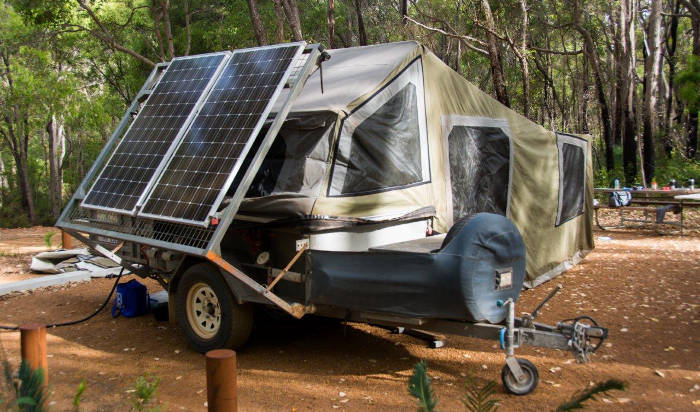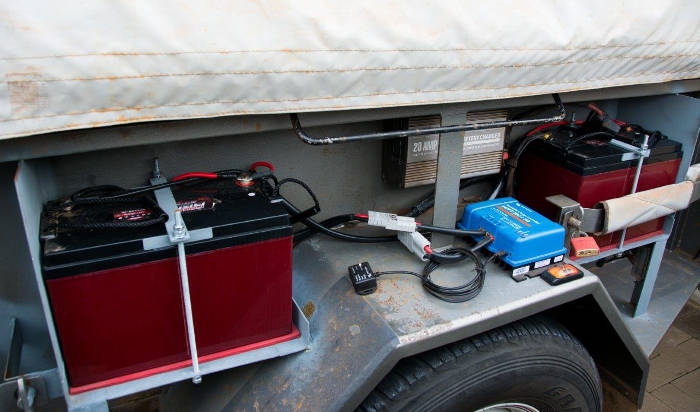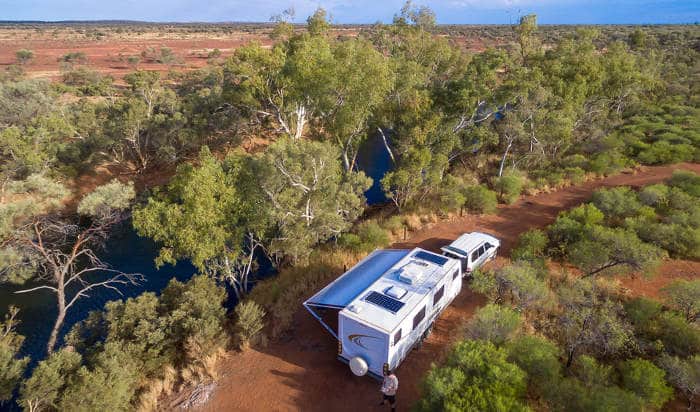Installing a camper trailer electrical system is an increasingly affordable and exciting option, particularly now that the cost of solar panels has continued to fall. A good quality, easy to use solar setup allows you to camp in one place without any fuss, and not have to rely on mains power at a park.
The size of the system you choose will depend on what you want to run. This will effect how many batteries you have, the number of solar panels, and the size of the solar inverter you choose.
Typical solar setup
Everyone’s off road energy requirements are different. It all depends on how long you intend to be be off road and what appliances you’re using.
A typical small solar setup may start with a single 200 watt solar panel (or two 100 watt panels) with a single 135ah battery. To keep you powered for 2 – 3 days with a good fridge or freezer, you may want a larger setup. This may comprise two 200 watt solar panels and two 135ah deep cycle batteries. This larger system should keep a fridge and freezer running and provide enough lighting comfortably, for a few days fishing or off road. You will need to calculate how much energy your fridge and freezer uses, as not all appliances will be the same.

Solar panels
The size of you camper trailer electrical system will depend on how long you intend to be off road and what you want to power. To work out how many solar panels you need, divide the amount of energy you need per day by the number of daylight hours.
Calculating the number of panels required
For example, if you need 1589 watts of power and you calculate you have 6 hours of sunlight per day, then you require at least 264 watts of solar panels (1589/6 = 264w). You’ll need to allow for cloudy days, dirty panels, and the fact that your system is never 100% efficient, so this should be factored into any calculation. You can do this by simply decreasing the number of daylight hours in your calculations. This will mean your final setup will be less likely to run out of power.
Installing in sequence or parallel
When solar panels are connected in your setup, they can be installed either in parallel or in sequence. This effects the maximum voltage you get from the system. For example, two 150 watt panels (each providing a maximum of 18 volts) when installed in parallel will provide the setup with 18 volts maximum. If the same two panels are installed in series, they will provide a maximum of 36 volts.
Sourcing panels
A final word about buying solar panels if you are doing it yourself. Be careful of cheap solar panels. There are plenty of cheap brands available online, and you can buy direct from China on ebay. Make sure you read reviews and shop around if you are doing the install yourself. Alternatively, if you’re not sure, get a professional to do it for you.
A solar setup can vary in price, depending on your requirements, but once all the equipment is bought, you get the benefit of free camping and free power. If you are doing it yourself, as much as you can purchase quality equipment that will give you the power you need and will be reliable. It’s simply better value for money.
Solar inverter
Solar panels catch the energy from the sun during the day to charge a single battery or multiple battery bank. But a solar setup requires an inverter/solar charger that regulates the voltage coming from the solar panels. Without a regulator you risk permanently damaging the batteries.
MPPT & PWM inverters
There are two types of inverters: MPPT (Maximum Power Point Tracking) and PWM (Pulse Width Modulation). Either of these types of inverters will work on your solar setup. MPPT is considerably more efficient (95 to 97% efficiency) compared to 75% efficiency for a PWM inverter. MPPT solar regulators are more expensive, however. They are recommended if you intend on using your solar setup regularly, because they provide maximum efficiency.

Batteries
The batteries in your solar setup are the heart of the system and it’s important to ensure you buy quality. Battery prices vary and you should avoid purchasing cheap, no-name batteries. Stick with a quality brand name that you know, like Camec. For more on the type of batteries, see caravan electrics explained.
Make sure you buy the same size batteries, and buy them at the same time in order to avoid equalisation issues. Batteries can be connected in parallel or in sequence. This will effect the maximum power of your solar setup.
Professional installation for camper trailer electrics
Plenty of DIYers install their own 12 volt systems, but there’s a bit of research involved to make sure you get the right sized system and value for money with the products you buy. There are also different set up configurations. If DIY isn’t your thing, you can get a professional, like the experts at Emu Caravan Repairs to help. We will install a camper trailer electrical system or do all your caravan electrics for you.

